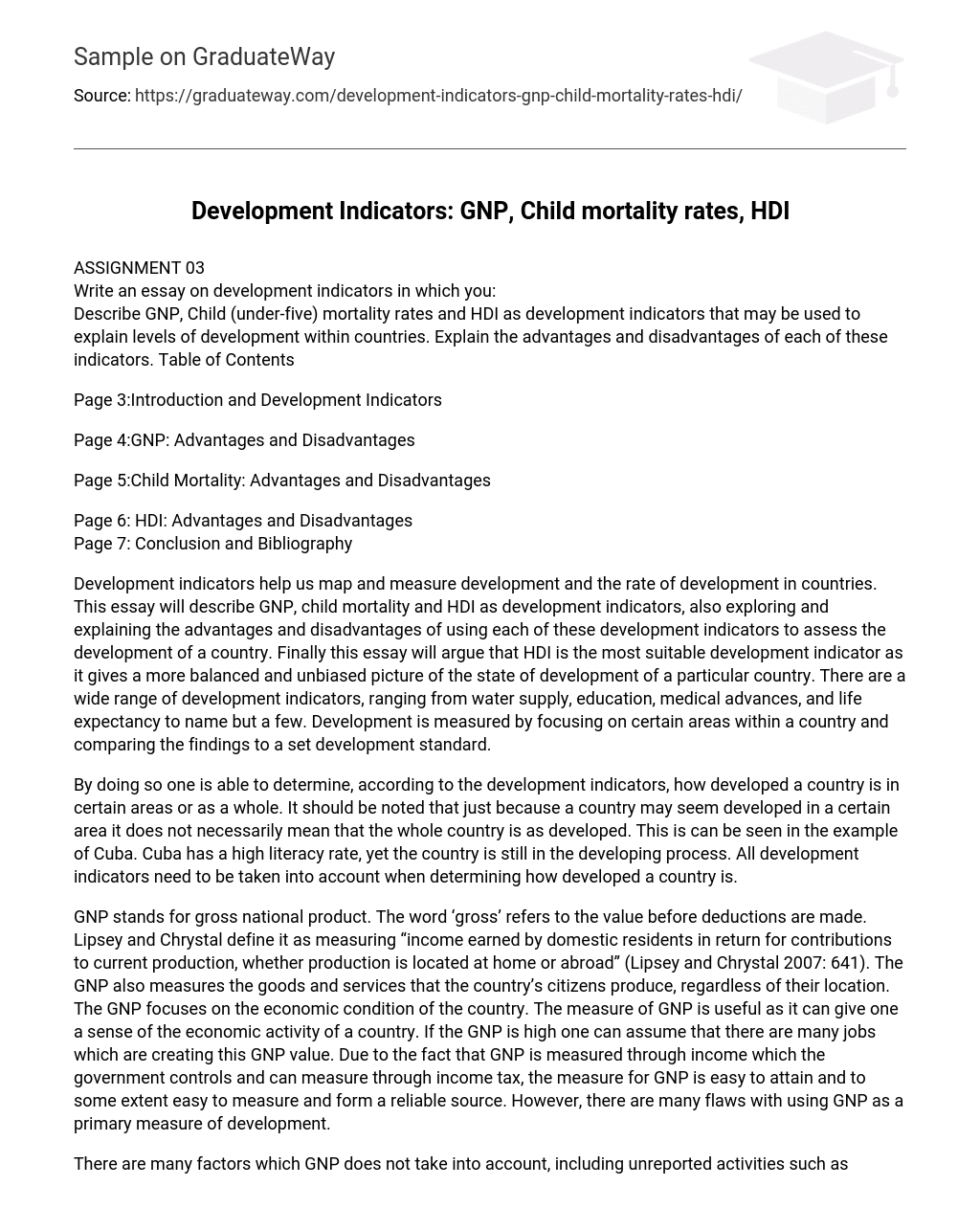The use of development indicators is crucial for mapping and evaluating development progress in different countries. This essay intends to explain and assess the importance of three main development indicators – GNP, child mortality, and HDI – while also exploring the pros and cons of using each indicator to measure a country’s development.
Finally, this essay will support the claim that HDI, the Human Development Index, is the most appropriate indicator for assessing development as it provides a more inclusive and impartial representation of a country’s progress. Various indicators, including water supply, education, medical advancements, and life expectancy, are employed to measure development by analyzing specific aspects within a nation and comparing them against established benchmarks.
When examining development indicators, it is possible to assess a country’s level of development in particular areas or as a whole. It is important to recognize that although a country may show advancement in certain aspects, this does not necessarily indicate complete development. Cuba serves as an example of this scenario; despite having a high literacy rate, the nation is still undergoing developmental processes. Thus, to accurately gauge a country’s level of development, all development indicators need to be considered.
GNP, also known as gross national product, is the monetary worth received by residents of a country in return for their involvement in ongoing production. According to Lipsey and Chrystal (2007: 641), GNP is calculated prior to any deductions and encompasses income earned domestically as well as internationally.
The Gross National Product (GNP) measures the goods and services produced by a country’s citizens, regardless of location, and provides insight into the country’s economic condition and level of activity. A high GNP indicates a robust job market. It is easily obtainable and measurable through income tax records, making it a reliable indicator. However, relying solely on GNP to assess development has limitations.
The exclusion of factors like informal trading, including underground and black market activities, from GNP calculations undermines its inclusivity as a measure of a nation’s income. These unreported economic interactions are not disclosed to tax authorities and therefore not accounted for in GNP. Additionally, GNP fails to consider the environmental harm caused in the production and procurement of goods and services.
GNP only measures the positive growth of the economy and ignores the negative aspects, which could hinder development. However, measuring the child mortality rate provides information about the country’s health services, food supply, water quality, and educational programs.
The significance of under five mortality as an indicator of development lies in its reflection of societal progress (Arnold et al 2006: 24). Both healthcare and education are viewed as integral components of development, and child mortality serves as a gauge of their efficacy. However, child mortality alone is deemed an inadequate measure of development since it solely takes into account the impact of healthcare and educational initiatives on a minority proportion of the population.
In addition, using the child mortality rate as a development indicator has a drawback. Simply analyzing the numbers alone does not reveal the specific causes and reasons for these deaths. Deaths can occur due to various factors such as famine, war, and the emergence of new diseases at different times. These factors do not necessarily indicate underdevelopment. Conversely, the Human Development Index (HDI) combines three indicators to assess a country’s progress and quality of life, serving as a measure of human advancement.
The text explores the concept of the Human Development Index (HDI), a comprehensive measurement that considers factors like life expectancy, education, and income. By assessing various aspects beyond wealth alone, the HDI enables countries to be ranked based on their level of human development. Krishana Mazumdar recognizes that development cannot be solely gauged by economic indicators like GNP or GDP but should also encompass enhancements in the quality of human life.
The HDI is considered a reliable measure of development because it considers the individuals affected by development and their needs. This is essential in evaluating development. Unlike the two measures mentioned earlier, the HDI takes multiple factors into consideration. By examining various indicators and factors impacting different aspects of society’s development, one can obtain an unbiased and comprehensive perspective on development.
By solely considering the GNP, one cannot grasp the progress in education or health. Similarly, relying only on child mortality paints a limited picture of health and an even narrower perspective on the economy. To obtain a comprehensive understanding of a country’s development across all sectors, the hybrid measure of HDI proves valuable. HDI emphasizes the well-being of individuals and their needs, which is pivotal in assessing development. By tracking HDI over time, one can observe the progress or absence thereof in development.
In summary, there are three measures of development applicable to a country: GNP, child mortality rates, and HDI. GNP effectively gauges economic activity, but it omits significant information.
Both child mortality rates and the figure lacked a comprehensive analysis of development. However, the HDI measure considered multiple factors, making it the most credible and appropriate indicator for development measurement. This inquiry is crucial for development scholars, as it underlies numerous developmental studies.
Bibliography
- Arnold, T. et al. 2006. 80:20. Development in an unequal World. 5th Ed. Ireland: 80:20 Educating and Acting for a Better World.
- Lipsey, RG. and Chrystal, KA. 2007. Economics, 11th Ed. United States: Oxford University Press.
- Muzumbar, K. 2003. A New Approach to Human Development Index, Review of Social Economy, 61 (4)





